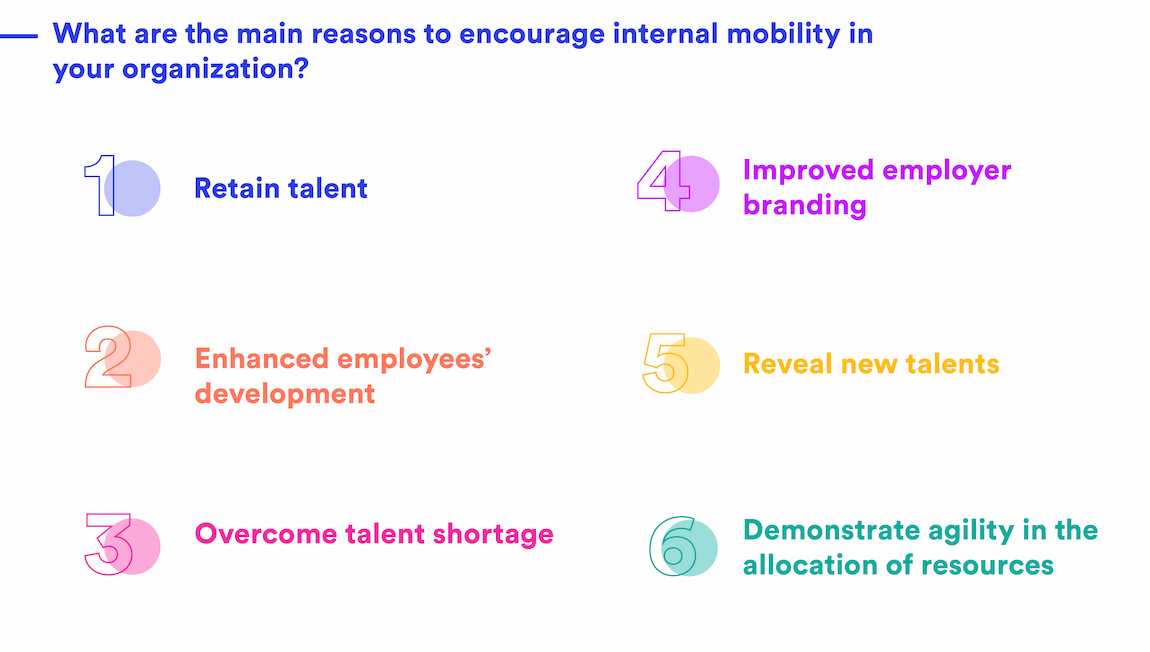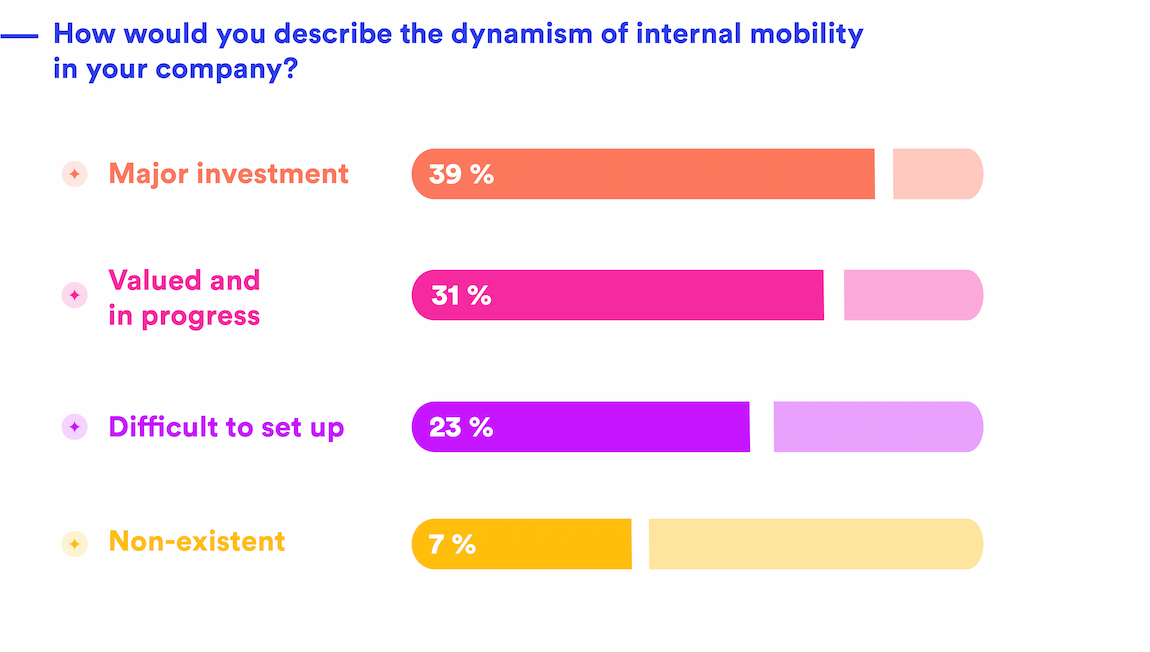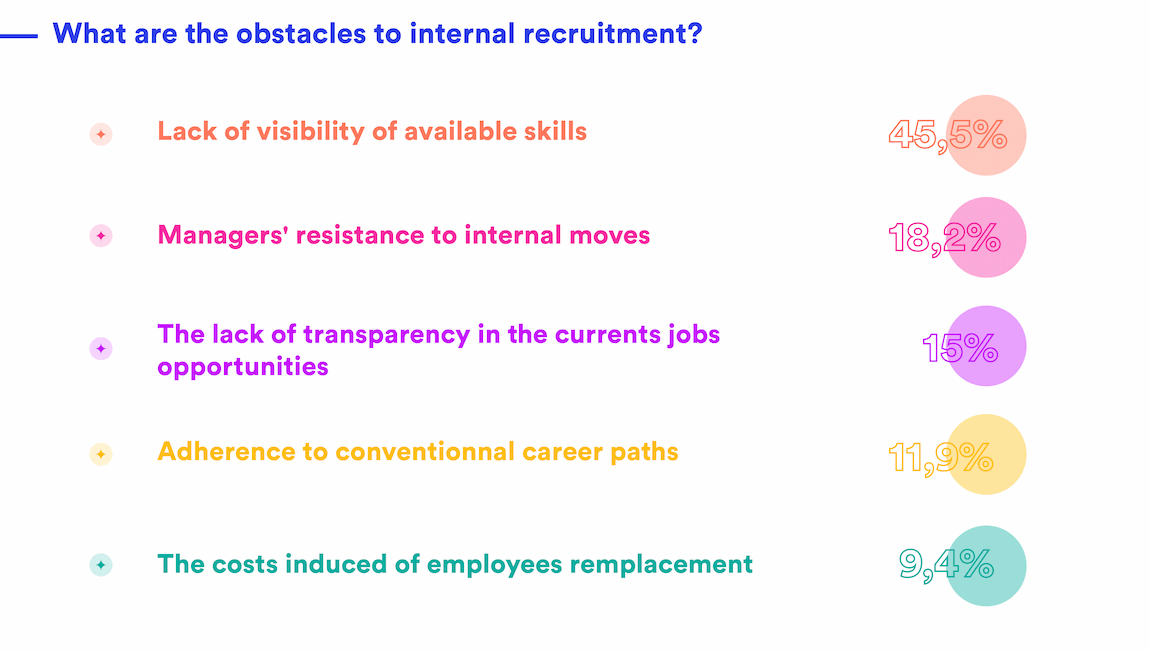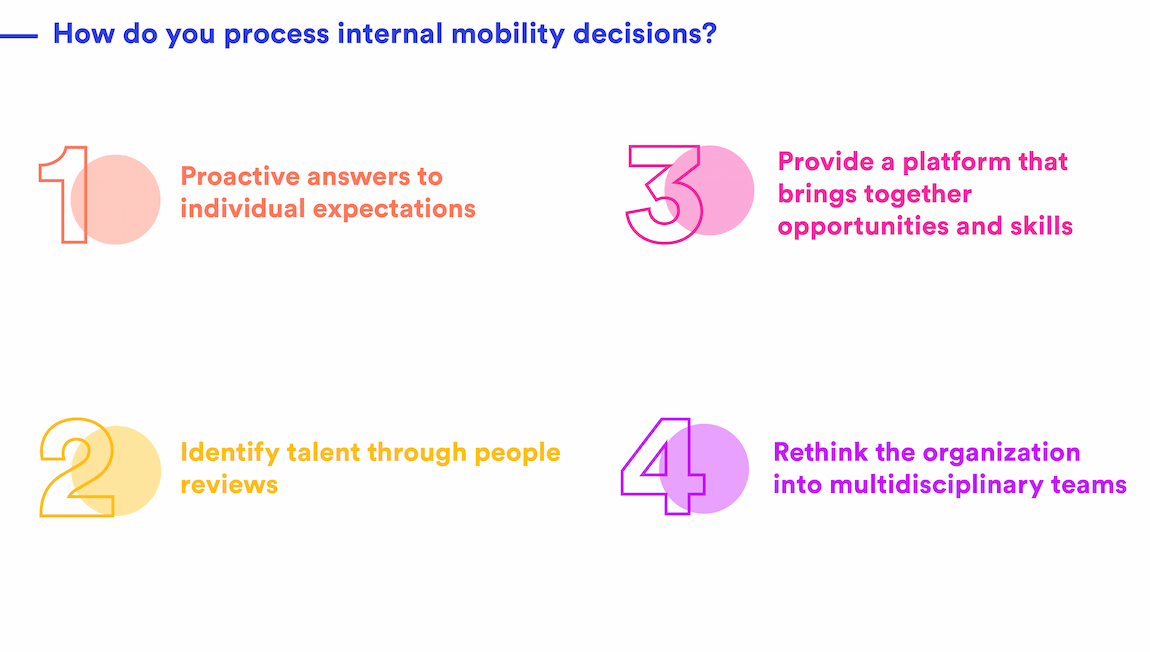As part of a study carried out in May 2023, we interviewed 117 human resources (HR) decision-makers from companies of different sizes and sectors in France. The aim of the study was to assess internal mobility practices and provide an overview of current trends. This article presents the key findings of this survey, which highlight the growing importance of internal mobility in French organizations.
Our internal recruitment survey panel
Participant profile :
The survey panel is made up of HR decision-makers, divided as follows according to their role:
- 41% come from HR Top Management
- 30% are responsible for HR development
- 21% are in charge of career management
- 6% belong to the “talent acquisition” department
- 2% are responsible for HR information systems (HRIS).
These HR professionals occupy key positions in their organizations and are well placed to assess internal mobility practices.
Panel features:
The companies that took part in the survey come in all shapes and sizes, giving us a real-life picture of how internal movements happen in different contexts.
Behaviour regarding internal recruitment opportunities
One of the key questions posed to participants was:“Are you seeing an increase in mobility requests?
The results showed that 87.1% of HR decision-makers answered in the affirmative, indicating a significant increase in requests for internal mobility within their organizations. Only 12.8% of respondents said they had not seen any such increase.
One of the most common obstacles is a feeling of apprehension on the part of employees about the reactions of their line managers to taking such proactive initiatives. These results suggest that employees are placing increasing importance on internal mobility, and are looking for opportunities to move up skills within their organization.
In the next sections of your article, you can analyze the survey results in more detail, including the reasons for this increase in mobility requests, the challenges facing companies and recommended initiatives to support and improve internal mobility practices.
The main drivers of internal recruitment
Among the reasons most often cited for boosting internal career paths, retention, speed and lower cost are highlighted. In this context, internal recruitment often mirrors the structured career paths commonly observed within large organizations.However, it is also interesting to note that this practice is also seen in terms of “real-life” development, which is in high demand among talented employees.
Finally, while the financial notion is motivating, it remains difficult to measure. Indeed, they depend on the ability of internal career management or recruitment teams to anticipate the “domino effects” triggered by an individual’s departure. Ultimately, this underlines the crucial need for the mobility solution selected to integrate seamlessly with both an applicant tracking system (ATS) and, above all, the strategic workforce planning tool in order to effectively anticipate staff flows.
This is what Bosch achieved as part of the transformation of its Rodez industrial site. Thanks to the Neobrain solution, 700 internal recruitments were carried out. Find out more about this success story.
HR teams’ perception of internal recruitment
Integrating a resource into a new role internally follows a process whose importance is similar to that of external recruitment.
What is an internal recruitment process?
The internal recruitment process identifies and selects candidates internally, offering employees the opportunity to apply for vacancies or to progress within the organization.
The approach is based on key elements such as job visibility, where opportunities are made accessible and can even be suggested to employees according to their skills and career aspirations.
This proactive approach encourages employees to consider career prospects within their company.
In addition, the dimension of exchanges between the old manager and the new one during the transition is of critical importance in guaranteeing harmonious continuity. These exchanges enable key information to be shared on the employee's know-how and driving forces, while facilitating a smooth transition to the new role.
You can find all our advice on how to conduct the internal mobility interview and ensure that the new form of collaboration lasts.
Our survey reveals a wide diversity in the maturity of internal mobility processes within their companies.
- Among the participants, 31% consider that their internal recruitment processes are valued and have reached a certain level of maturity, testifying to a recognition of the importance of these practices.
- On the other hand, 39% feel that their approach to internal mobility still requires further development. This underscores the desire to improve and strengthen existing processes in order to promote smooth, efficient mobility.
- Nevertheless, 23% of participants felt that the implementation of internal recruitment represented a real difficulty, suggesting obstacles to be overcome for a smoother integration of internal mobility.
- Finally, 7% of respondents have not yet fully explored the subject of internal mobility, highlighting the need to raise awareness of the benefits and opportunities offered by these processes. These figures show a diversity of perspectives and underline the importance of continuing to evolve and improve internal mobility practices within companies.
What is the proportion of internal recruitment in total recruitment?
Our panel has no universal scope, but here are a few conclusions:
- ⅔ of new hires are external
- ⅓ come from existing employees
This balance can be analyzed in several ways:
- The rapid pace of change in the business requires the company to acquire external skills resources, thus renewing ideas and introducing new expertise from different horizons.
- At the same time, the company has become aware of the disadvantages of external recruitment, and is looking to strengthen its talent development programs and enable employees to progress their careers within the organization.
- Finally, a form of balance between the need to maintain continuity in skills and internal knowledge, while integrating new resources and perspectives, contributes to a healthy organizational dynamic, combining stability and innovation.
Obstacles to internal recruitment
The survey results show that transparency and visibility of opportunities for internal candidates, on the one hand, and skills, for internal recruiters, on the other, are at the root of 60% of obstacles to internal mobility.
Among these obstacles, 45% of HR managers cited the “lack of visibility of available skills ” as a major hindrance. This underscores the importance of putting in place mechanisms to identify and enhance the value of internal skills , in order to make them more visible and accessible to HR decision-makers. A better understanding of the skills available within the organization would facilitate internal recruitment decisions.
In addition, 15% of obstacles are linked to a “lack of knowledge of the reality of internal professions”. This highlights the importance for HR professionals of familiarizing themselves with the different functions and professions within the company, in order to better understand the skills required and the career bridges. A better understanding of the realities of in-house professions would enable us to identify potential candidates more effectively and promote internal development opportunities.
Other reasons cited included “managerial resistance” (18%), who may fear losing a valuable resource, or have a perception that the know-how required can only be found outside the company. It is essential to make managers aware of the importance of internal mobility and to actively involve them in the internal recruitment process, highlighting the benefits of developing in-house talent and providing them with tools to assess the skills available in-house.
Finally, “career conservatism” is also mentioned as an obstacle to internal recruitment. It is necessary to promote a corporate culture that encourages employees to become active players in their own careers, by exploring opportunities for non-traditional career paths. This can be achieved by providing opportunistic offers and reflections on internal know-how and ambitions, to demonstrate the mutual benefits of such an approach.
We have dedicated an article to the subject of career individualization, made possible by talent management and modern tools.
Levers for increasing internal movement
In short, these results underline the importance of overcoming the disincentives to internal recruitment by improving transparency, visibility of opportunities and awareness of internal skills . This requires a proactive approach on the part of HR professionals, in collaboration with managers and employees, to foster a dynamic internal mobility culture that benefits everyone in the organization.
What are the practical solutions for developing internal mobility?
Neobrain has developed a "career galaxy" which enables employees to visualize the various possible career paths. Here's how it looks on our platform.
The solutions for developing internal mobility consist of 3 instruments:
- Ongoing assessment of performance and commitment , leading to objective information on the resources available. Link to more resources on best practices in continuous monitoring.
- Collaboration between HR and the business units through career committees, fed throughout the year by a system that guides managers in identifying the high potential of their teams. Here are the keys to a people review that keeps its promises.
- Tools like those offered by today’s talent marketplaces. You can find out everything you need to know about this environment, designed in particular for mobility, in this comprehensive “Internal Talent Marketplace” guide.












